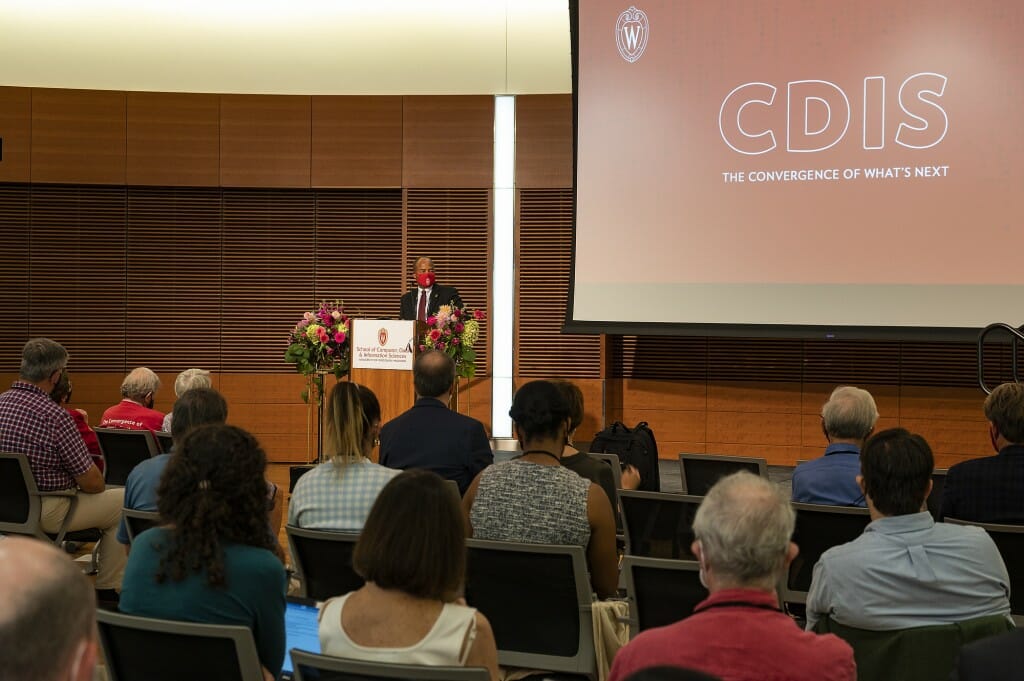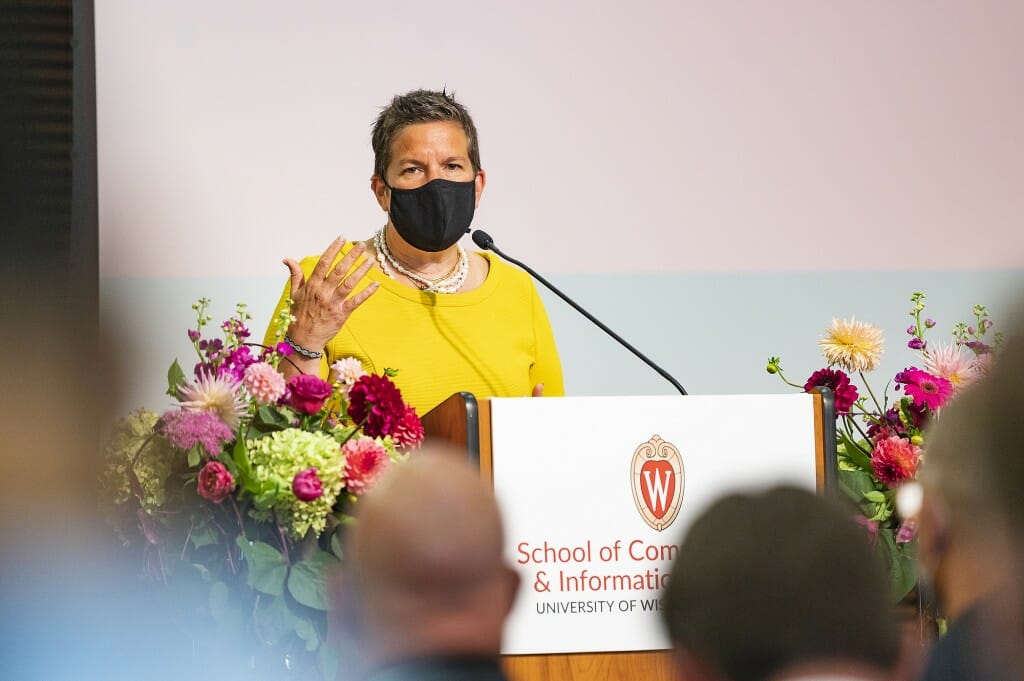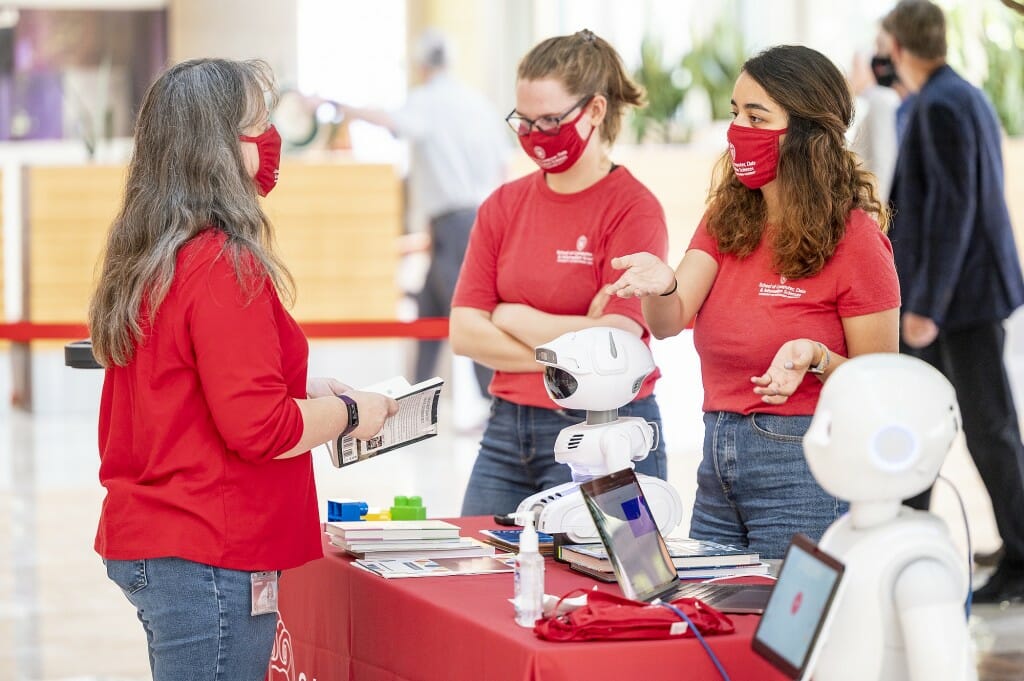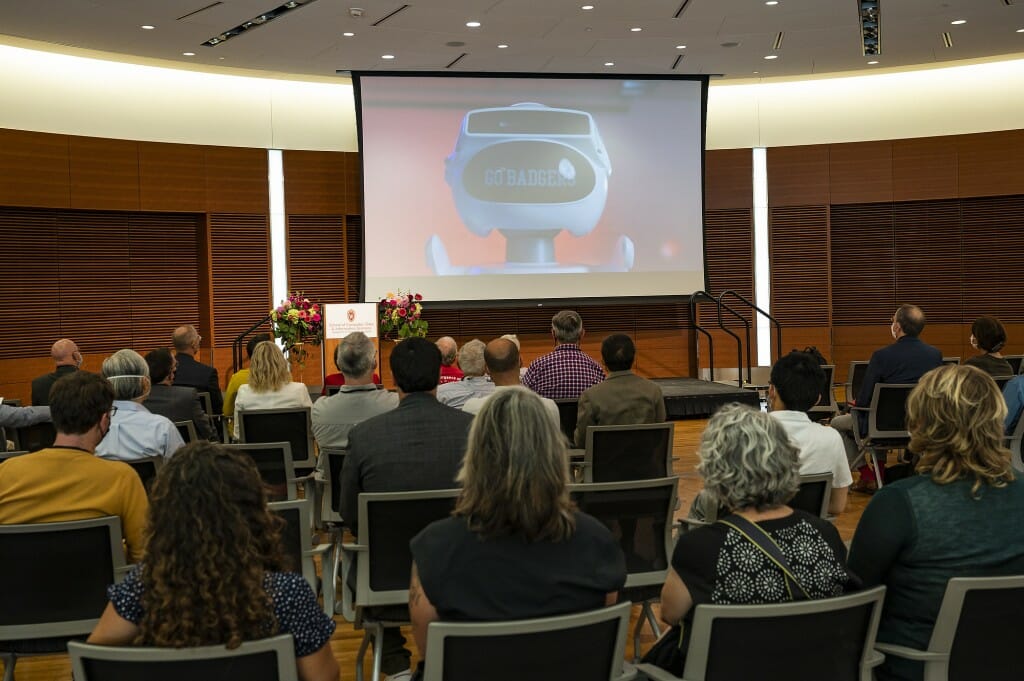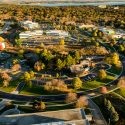$175 million commitment helps launch UW–Madison School of Computer, Data & Information Sciences, support transformative mission
The University of Wisconsin–Madison’s School of Computer, Data & Information Sciences — a unique, forward-thinking collaboration focused at the intersection of technology and humanity — is announcing a $175 million private investment and launching an effort to raise an additional $50 million to establish a new beacon for high tech in Wisconsin housed in a state-of-the-art facility in the center of campus.
CDIS brings together UW–Madison’s highly ranked Computer Sciences and Statistics departments and the Information School. The new facility will be a hub for the bustling tech ecosystem in Wisconsin, fostering academic research, supporting booming student interest, and hosting collaborations with industry and community partners. Designed to be the most sustainable building on campus, the new facility will also focus on creating a more inclusive and diverse tech community.
“The School of Computer, Data & Information Sciences is a place where our faculty and students will shape the way technology influences and enriches our lives. This is an investment that is central to the future of the university, as these fields are infusing and changing all other academic disciplines,” says UW–Madison Chancellor Rebecca Blank. “We are fortunate to have the support of visionary alumni John and Tashia Morgridge and the Wisconsin Alumni Research Foundation, a partner in extending the impact of UW–Madison ideas to the world, to build a new home for the school’s vital work.

Tashia and John Morgridge Photo by David Nevala
With a commitment of $125 million from the Morgridges — $50 million of which is in the form of a challenge grant, providing a 1-to-1 match to raise another $50 million from other generous donors who see the importance of CDIS’ mission — and $50 million from WARF, UW–Madison will use these funds to build a new, 300,000-square-foot home for the school. The gifts were announced today at an event in the Discovery Building, across the 300 block of Orchard Street from the site of the planned CDIS building.
“This is an investment in UW–Madison and the state of Wisconsin that will help secure their place in our shared future,” says John Morgridge, a 1955 UW–Madison graduate who helped build a leading global innovator and supplier of computer networking products as president, CEO and chairman of the board of Cisco Systems. “Tashia and I hope our commitment will inspire others to see the transformative potential of this project and help get it over the finish line.”
Private funding for the building, which will also house the Center for High Throughput Computing, the American Family Insurance Data Science Institute and the Department of Biostatistics & Medical Informatics, will speed construction scheduled to begin in 2023 and wrap by the end of 2024.
“We’re thrilled to join our partners today in launching a new era for the UW School of Computer, Data & Information Sciences,” says Erik Iverson, CEO of WARF, the nonprofit foundation that provides patenting, licensing and technology development for UW–Madison research. “We’ve come together because we share the vision of this campus catalyzing technologies with the power to shape societies. The mixing of disciplines in the School and its innovative new facility will enable intellectual collisions that will further drive innovation.”
It’s a vision that lends a competitive advantage across industries, spawns entrepreneurship, and drives innovative pursuits both scientific and humanitarian, according to Tom Erickson, founding director of CDIS, a veteran tech entrepreneur, and a UW–Madison electrical and computer engineering graduate.
“Society uses data and technology across every facet of industry and in our personal lives — from medicine to engineering to agriculture. Students and faculty in virtually every discipline require digital skills – establishing new table stakes in higher ed,” Erickson says. “CDIS helps our students pair the power of digital sciences with the almost unmatched breadth of highly regarded education and research programs at UW–Madison.”
“The school will enhance our ability to tackle the big challenges in data-rich sciences such as climate science, physics, and astronomy,” says Eric Wilcots, professor of astronomy and dean of the College of Letters & Science, administrative home to CDIS and many of the complementary academic disciplines seeking the forward-thinking digital programs offered by CDIS. “The transformative power of CDIS is in the intersection of computing and data with the humanities and social sciences. This is how UW–Madison distinguishes itself amongst our peers.”
CDIS’ three units are now home to more than 3,600 undergraduate and graduate students studying software design, robotics, machine learning, cybersecurity, information retrieval, and much more. The computer science major alone grew from 200 students to 2,000 over the last decade, with more than 40 percent of them matching computer science with double- or even triple-majors that will propel them into the workforce with a wide range of needed abilities.
“It is clear that our undergraduates understand the importance of incorporating computing, data, and information in their education. These are the skills that are in demand today across all sectors,” Wilcots says. “What is impressive is that so many of our students are already choosing to combine majors in the humanities, social sciences, and natural scienes with computer sciences and data science. Centering CDIS in the College of Letters & Science enables our students to forge these innovative combinations of majors and prepare themselves for the careers of the future.”
Graduates from CDIS programs are sought-after in every industry, and Madison’s prominence as a technology hub is growing. The Brookings Institution and Information Technology and Innovation Foundation put Madison atop their list of growth centers for tech innovation in 2019, emphasizing the importance of innovations and concentration of skilled workers drawn to and created by UW–Madison. LinkedIn recently named Madison the top city in the country for technology job growth during the pandemic.
CDIS research collaborations are already exploring how social media shapes and reveals the direction of public opinion, how data can help supercharge clinical trials, how to help the visually impaired interact with data, and the development of ultra-high-resolution, long-range 3D imaging.
“We’re focused on a future that connects what is happening now with what happens next,” Erickson says. “The generous support of the Morgridges and WARF will complete the tech corridor on campus and further establish Madison as the next major innovation center in the country. The interdisciplinary uniqueness of our program coupled with its popularity will drive economic growth throughout the region.”



